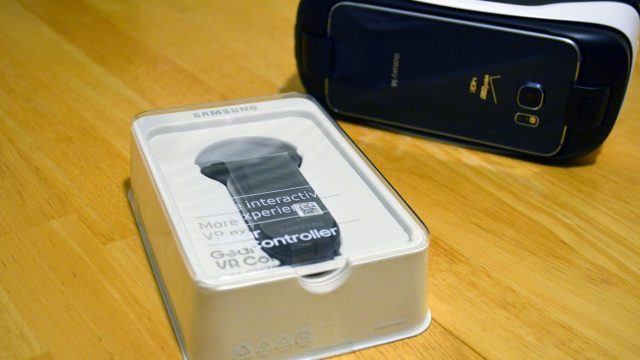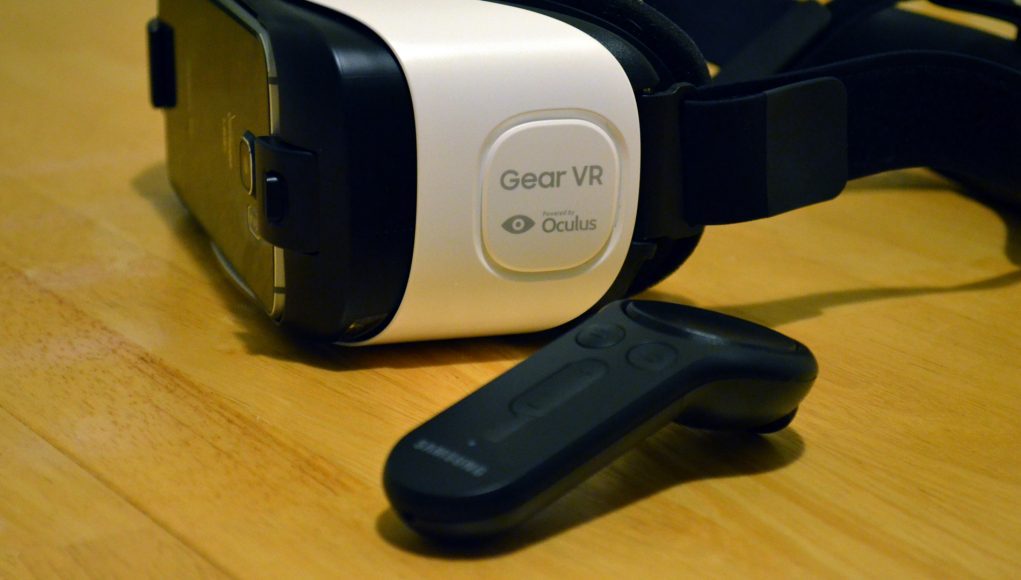Experience
Inside the Gear VR Controller is a little IMU which allows the controller to sense rotation only. This is an important distinction from a controller like Oculus Touch which can detect not just rotation but also translation (the forward-back, left-right, and up-down motions, also called ‘positional tracking’). Gear VR (the headset) itself is in the same boat, supporting only rotational tracking and not positional tracking. That said, Oculus has done some modeling so that the controller rotates around a point somewhat near your elbow, so that the visual representation in VR looks a little more natural than the model of the controlling simply rotating around a single point.
With rotational tracking only (same as the Daydream controller), that means that the Gear VR Controller is only capable of somewhat basic motion input. You won’t exactly be able to ‘reach out’ and grab things from within the world as if it was your own hand, or do anything like boxing or throwing a football, but you will be able to point and rotate, so expect many apps to have a laser-pointer-like approach to input.
That said, this is a nice improvement to the old method, which was almost exclusively gaze-based input, where you had to use your head to move a cursor to select items, shoot enemies, and enter text. Now with the Gear VR Controller (and a properly supported game), moving your head falls back to the much more natural realm of just looking, while you get to use your hand to do the pointing. It seems simple, but it actually makes using Gear VR not just more comfortable but a bit more immersive too because you’re using your head and hands in a more natural way inside the virtual world.
As with most devices which can only track rotation, the Gear VR Controller (just like the headset) has some drift. You’ll be prompted to calibrate the controller during setup (which involves moving the controller in a figure-eight shape), and while this helps avoid drift, it doesn’t eliminate it entirely. Fortunately, you can hold down the Home button on the controller at any time to quickly recenter it; you’ll likely need to do this once every 10 minutes or so, possibly more if you’re playing while sitting on a rotating chair.
Oculus Home
The entire Oculus Home menu on Gear VR now has support for the Controller, including the System menu which you can pull up by holding the Back button. On the familiar Oculus Home menu screen, you’ll now be able to point and select to navigate in a way that feels much more natural than using the headset’s side-mounted trackpad and your head for aiming.
Supported Apps
A launch Oculus is promising support for some 20 apps in April, with 50 more to come “over the next few months.” Some existing apps, like Drop Dead, have been updated to support the Gear VR Controller, while others, like the upcoming Monzo, are all new and support the Controller out of the gate. So far I haven’t spotted any ‘Controller Required’ apps, which means even those that do can still technically be played without it, though Gear VR has a number of ‘Gamepad Required’ games, so it’s possible that we’ll see some apps which require the Controller to be played at all.
For games like Viral Quarantine and Monzo, the Gear VR Controller is a natural fit. In the former, aiming to take down enemies with your hand and a trigger is a far superior experience to using the side-trackpad to shoot while aiming with your face to do the same. Monzo—which allows players to construct, paint, and decorate model sets—benefits from the Controller quite a bit because it’s much faster to grab pieces and move them into place with your hand, and they’re easier to manipulate too.
Full Backwards Compatibility With Older Apps
While we think that Samsung is likely to push the Gear VR Controller to become the defacto input method for the platform, with more than 700 apps on Gear VR currently, it’s going to take some time before even a quarter of apps get native support for the Controller.
In the meantime there’s full-backwards compatibility. That means that even for an old game which wasn’t made with the controller in mind, you’ll still be able to use the controller to play the game, as the device quite easily emulates all the same functionality of the head-mounted trackpad and buttons.

So in an older game like Smash Hit VR, (which currently doesn’t even know that the controller exists) you can play the game in full using the Trigger to shoot balls to smash your way to victory as if you were tapping on the side-trackpad itself. You’ll still need to aim with your face, but at least you can keep your arm down and use a trigger instead of a tap for shooting.
Compatibility with Older Gear VR Hardware
Although the Gear VR Controller was announced alongside the latest Gear VR headset, our understanding is that the device is compatible with all models of Gear VR except for the very first (which only supported the Note 4). In my testing I was using a Galaxy S6 phone and the second Gear VR headset (2015 Innovator Edition, SM-R321) and I was able to connect the Gear VR Controller and use it flawlessly.
Conclusion
 The Gear VR Controller is a no-brainer as an add-on or a bundle purchase alongside a new Gear VR headset, thanks to its ability to unlock a more natural and immersive way of interacting with mobile VR content that brings the device in line with its leading competitor, Google Daydream. It’s compact and feels as well built as Gear VR itself, with a painless pairing and calibration process. With only a handful of apps natively supporting the controller at launch, all but hardcore Gear VR users can likely stand to wait to make the purchase until there’s broader app support (or at least until a favorite app sees an update to add support).
The Gear VR Controller is a no-brainer as an add-on or a bundle purchase alongside a new Gear VR headset, thanks to its ability to unlock a more natural and immersive way of interacting with mobile VR content that brings the device in line with its leading competitor, Google Daydream. It’s compact and feels as well built as Gear VR itself, with a painless pairing and calibration process. With only a handful of apps natively supporting the controller at launch, all but hardcore Gear VR users can likely stand to wait to make the purchase until there’s broader app support (or at least until a favorite app sees an update to add support).







